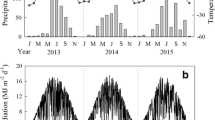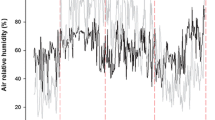Abstract
The importance of photodegradation in surface litter decomposition has recently been recognized in arid and semi-arid terrestrial ecosystems, yet its importance in decomposing dense litter and the mechanisms through which it acts remain unclear. We investigated how ultraviolet (UV) radiation exposure and litter position affected decomposition processes in a California annual grassland. In a split-plot design, we exposed Bromus diandrus litter to two levels of UV radiation (UV pass and UV block) at two aboveground locations (at the top, suspended above the litter layer, and at the bottom of the litter layer) for 1 year. We found that UV radiation increased the litter decay constant by 23% at the top location over 1 year, consistent with the occurrence of photodegradation. Surprisingly, UV radiation also increased the litter decay constant by 30% at the bottom location over 1 year. We speculate that photodegradation indirectly increased microbial decomposition through priming effects. Overall, litter in the top location had a 29% higher decay constant than litter in the bottom location. In terms of litter chemistry, exposure to UV radiation increased loss of hemicellulose by 26%, but not loss of lignin. Litter in the bottom location exhibited greater loss of the cell solubles fraction and greater nitrogen immobilization, but lower loss of hemicellulose than litter in the top location. Our results demonstrate that litter position significantly regulates the contribution of photodegradation to overall decomposition, both through direct (top location) and indirect (bottom location) effects. Therefore, better quantification of both direct and indirect effects of photodegradation can greatly improve understanding of biogeochemical cycling in grasslands.





Similar content being viewed by others
References
Adair EC, Parton WJ, Del Grosso SJ, Silver WL, Harmon ME, Hall SA, Burke IC, Hart SC. 2008. Simple three-pool model accurately describes patterns of long-term litter decomposition in diverse climates. Glob Chang Biol 14:1–25.
Aerts R. 1997. Climate, leaf litter chemistry and leaf litter decomposition in terrestrial ecosystems: a triangular relationship. Oikos 79:439–49.
Anderson JM. 1973. The breakdown and decomposition of sweet chestnut (Castanea sativa Mill.) and beech (Fagus sylvatica L.) leaf litter in two deciduous woodland soils. Oecologia 12:251–74.
Austin AT. 2011. Has water limited our imagination for aridland biogeochemistry? Trends Ecol Evol 26:229–35.
Austin AT, Ballaré CL. 2010. Dual role of lignin in plant litter decomposition in terrestrial ecosystems. Proc Natl Acad Sci 107:2–6.
Austin AT, Vivanco L. 2006. Plant litter decomposition in a semi-arid ecosystem controlled by photodegradation. Nature 442:555–8.
Berg B, McClaugherty C. 2008. Plant litter: decomposition, humus formation, carbon sequestration. Berlin: Springer.
Brandt LA, King JY, Milchunas DG. 2007. Effects of ultraviolet radiation on litter decomposition depend on precipitation and litter chemistry in a shortgrass steppe ecosystem. Glob Chang Biol 13:2193–205.
Brandt LA, Bohnet C, King JY. 2009. Photochemically induced carbon dioxide production as a mechanism for carbon loss from plant litter in arid ecosystems. J Geophys Res 114:G02004.
Brandt LA, King JY, Hobbie SE, Milchunas DG, Sinsabaugh RL. 2010. The role of photodegradation in surface litter decomposition across a grassland ecosystem precipitation gradient. Ecosystems 13:765–81.
Burnham KP, Anderson DR. 2002. Model selection and multimodel inference: a practical information-theoretic approach. New York: Springer.
Christensen BT. 1986. Barley straw decomposition under field conditions: effect of placement and initial nitrogen content on weight loss and nitrogen dynamics. Soil Biol Biochem 18:523–9.
Coŭteaux M-M, Bottner P, Berg B. 1995. Litter decomposition, climate and litter quality. Trends Ecol Evol 10:63–6.
Day TA, Zhang ET, Ruhland CT. 2007. Exposure to solar UV-B radiation accelerates mass and lignin loss of Larrea tridentata litter in the Sonoran Desert. Plant Ecol 193:185–94.
Deshmukh I. 1985. Decomposition of grasses in Nairobi National Park, Kenya. Oecologia 67:147–9.
Dukes JS, Field CB. 2000. Diverse mechanisms for CO2 effects on grassland litter decomposition. Glob Chang Biol 6:145–54.
Feng X, Hills KM, Simpson AJ, Whalen JK, Simpson MJ. 2011. The role of biodegradation and photo-oxidation in the transformation of terrigenous organic matter. Org Geochem 42:262–74.
Gallo ME, Sinsabaugh RL, Cabaniss S. 2006. The role of ultraviolet radiation in litter decomposition in arid ecosystems. Appl Soil Ecol 34:82–91.
Gehrke C, Johanson U, Callaghan TV, Chadwick D, Robinson CH. 1995. The impact of enhanced ultraviolet-B radiation on litter quality and decomposition processes in Vaccinium leaves from the Subarctic. Oikos 72:213–22.
George B, Suttie E, Merlin A, Deglise X. 2005. Photodegradation and photostabilisation of wood—the state of the art. Polym Degrad Stab 88:268–74.
Gessler PE, Chadwick OA, Chamran F, Althouse L, Holmes K. 2000. Modeling soil—landscape and ecosystem properties using terrain attributes. Soil Sci Soc Am J 64:2046–56.
Hatfield R, Fukushima RS. 2005. Can lignin be accurately measured? Crop Sci 45:832–9.
Hatfield RD, Jung HG, Ralph J, Buxtond DR, Weimeraq PJ. 1994. A comparison of the insoluble residues produced by the Klason lignin and acid detergent lignin procedures. Phytochemistry 65:51–8.
Henry HAL, Brizgys K, Field CB. 2008. Litter decomposition in a California annual grassland: interactions between photodegradation and litter layer thickness. Ecosystems 11:545–54.
Hewins D, Archer S, Okin G, McCulley R, Throop H. 2013. Soil–litter mixing accelerates decomposition in a Chihuahuan desert grassland. Ecosystems 16:183–95.
Hobbie SE. 2000. Interactions between litter lignin and soil nitrogen availability during leaf litter decomposition in a Hawaiian montane forest. Ecosystems 3:484–94.
Holland EA, Coleman DC. 1987. Litter placement effects on microbial and organic matter dynamics in an agroecosystem. Ecology 68:425–33.
Hughes KA, Lawley B, Newsham KK. 2003. Solar UV-B radiation inhibits the growth of Antarctic terrestrial fungi. Appl Environ Microbiol 69:1488–91.
Johnson D. 2003. Response of terrestrial microorganisms to ultraviolet-B radiation in ecosystems. Res Microbiol 154:315–20.
Jung HG, Varel VH, Weimer PJ, Ralph J. 1999. Accuracy of Klason lignin and acid detergent lignin methods as assessed by bomb calorimetry. J Agric Food Chem 47:2005–8.
King JY, Brandt LA, Adair EC. 2012. Shedding light on plant litter decomposition: advances, implications and new directions in understanding the role of photodegradation. Biogeochemistry 111:57–81.
Kuzyakov Y, Friedel JK, Stahr K. 2000. Review of mechanisms and quantification of priming effects. Soil Biol Biochem 32:1485–98.
Lee H, Rahn T, Throop H. 2012. An accounting of C-based trace gas release during abiotic plant litter degradation. Glob Chang Biol 18:1185–95.
McLauchlan KK, Hobbie SE, Post WM. 2006. Conversion from agriculture to grassland builds soil organic matter on decadal timescales. Ecol Appl 16:143–53.
Meentemeyer V. 1978. Macroclimate and lignin control of litter decomposition rates. Ecology 59:465–72.
Melillo JM, Aber JD, Muratore JF. 1982. Nitrogen and lignin control of hardwood leaf litter decomposition dynamics. Ecology 63:621–6.
Moorhead DL, Currie WS, Rastetter EB, Parton WJ, Harmon ME. 1999. Climate and litter quality controls on decomposition—an analysis of modeling approaches. Glob Biogeochem Cycl 13:575–89.
Nagy LA, Macauley BJ. 1982. Eucalyptus leaf-litter decomposition: effects of relative humidity and substrate moisture content. Soil Biol Biochem 14:233–6.
Pancotto V, Sala O, Cabello M, López NI, Robson TM, Ballaré CL, Caldwell MM, Scopel AL. 2003. Solar UV-B decreases decomposition in herbaceous plant litter in Tierra del Fuego, Argentina: potential role of an altered decomposer community. Glob Chang Biol 9:1465–74.
Quideau S, Graham R, Oh S, Hendrix P, Wasylishen R. 2005. Leaf litter decomposition in a chaparral ecosystem, Southern California. Soil Biol Biochem 37:1988–98.
Rozema J, Tosserams M, Nelissen HJM, Van Heerwaarden L, Broekman RA, Flierman N. 1997. Stratospheric ozone reduction and ecosystem processes: enhanced UV-B radiation affects chemical quality and decomposition of leaves of the dune grassland species Calamagrostis epigeios. Plant Ecol 128:285–94.
Rutledge S, Campbell DI, Baldocchi D, Schipper LA. 2010. Photodegradation leads to increased carbon dioxide losses from terrestrial organic matter. Glob Chang Biol 16:3065–74.
Smith WK, Gao W, Steltzer H, Wallenstein MD, Tree R. 2010. Moisture availability influences the effect of ultraviolet-B radiation on leaf litter decomposition. Glob Chang Biol 16:484–95.
Throop HL, Archer SR. 2007. Interrelationships among shrub encroachment, land management, and litter decomposition in a semidesert grassland. Ecol Appl 17:1809–23.
Thurow TL. 1989. Decomposition of grasses and forbs in coastal savanna of southern Somalia. Afr J Ecol 27:201–6.
Van Soest PJ. 1963. Use of detergents in the analyses of fibrous feeds. A rapid method for the determination of fiber and lignin. J Assoc Off Anal Chem 46:829–35.
Van Soest PJ. 1965. Symposium on factors influencing the voluntary intake of herbage by ruminants: voluntary intake in relation to chemical composition and digestibility. J Anim Sci 24:834–43.
Von Lützow M, Kögel-Knabner I, Ekschmitt K, Flessa H, Guggenberger G, Matzner E, Marschner B. 2007. SOM fractionation methods: relevance to functional pools and to stabilization mechanisms. Soil Biol Biochem 39:2183–207.
Yanni SF, Whalen JK, Simpson MJ, Janzen HH. 2011. Plant lignin and nitrogen contents control carbon dioxide production and nitrogen mineralization in soils incubated with Bt and non-Bt corn residues. Soil Biol Biochem 43:63–9.
Zar JH. 1999. Biostatistical analysis. Upper Saddle River, NJ: Prentice Hall.
Acknowledgments
We thank Dad Roux-Michollet, Keri Opalk, Kenneth Marchus, Matt Mass, Viviane Vincent, Molly Zimmerman, and Heather Christian for their assistance in the field and lab. We thank Oliver Chadwick and Carla D’Antonio for their valuable comments on the experimental design and on this manuscript. We thank Kate McCurdy, Eric Massey, and the University of California’s Sedgwick Reserve for providing the study site, field facilities, and technical support. This work was supported by the National Science Foundation under DEB-0935984.
Author information
Authors and Affiliations
Corresponding author
Additional information
Author Contributions
YL and JK designed the study; YL conducted the field study and lab analyses with contributions from JK; and YL and JK analyzed the data and wrote the paper.
Rights and permissions
About this article
Cite this article
Lin, Y., King, J.Y. Effects of UV Exposure and Litter Position on Decomposition in a California Grassland. Ecosystems 17, 158–168 (2014). https://doi.org/10.1007/s10021-013-9712-x
Received:
Accepted:
Published:
Issue Date:
DOI: https://doi.org/10.1007/s10021-013-9712-x




